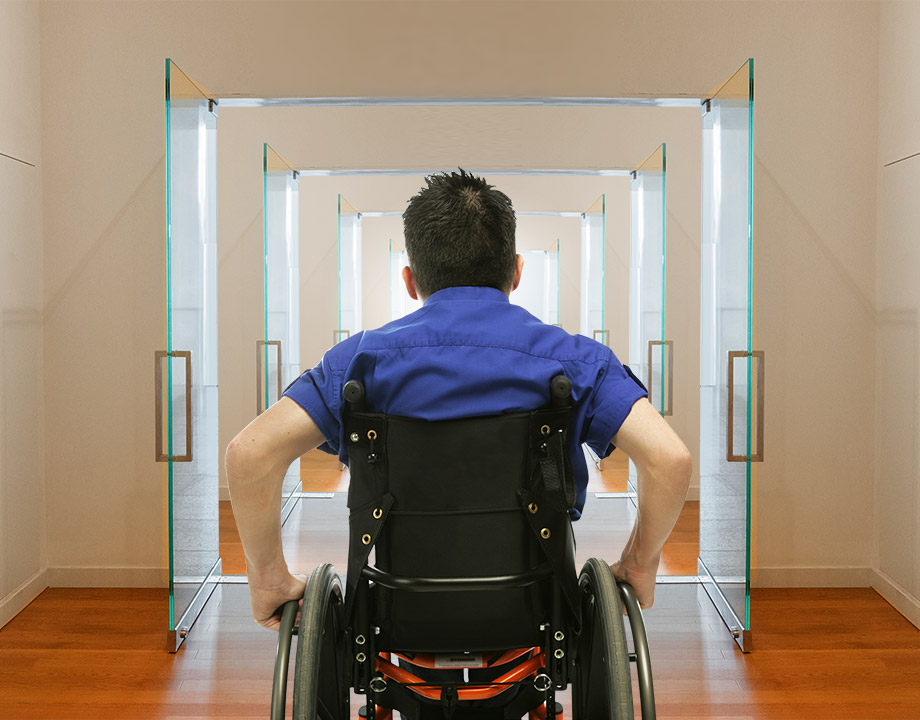Tech to Open Doors Remotely From a Wheelchair
Tech to Open Doors Remotely From a Wheelchair


Engineering students invent technology to automatically open doors for wheelchair users. Photo: Portal Entryways
Unfortunately, people with physical disabilities or non-permanent injuries affecting mobility know that navigating accessible doorways is often more difficult than imagined, regardless of their alleged handicap accessibility.
An engineering student at Brigham Young University, Josh Horne, discovered this while idea-hunting for a year-long innovation fellowship in which he was participating. He and his fellowship heard a story of a young woman in a wheelchair who found herself stuck in the snow; graciously, the football team discovered her, secured her in the back of their pickup truck, and drove her to school.
“We thought that was a crazy story,” Horne said. “We wanted to talk to her and see if there was any way to make her life any easier.”
They did speak with her, and quickly learned the most stressful parts of her day concerned moving her wheelchair through doors; doors that, in theory, were wheelchair accessible. Yet, most of those doors put wheelchair users through demanding troublesome situations.
Doors that open automatically after pushing a button, for instance, are problematic for people without full use of arms; pushing buttons can prove difficult—if not impossible—for those with certain disabilities. Often, the buttons are located in areas near the door that force a wheelchair to make a complicated maneuver in order to reach it.
Additionally, doors can actually close before a disabled person has time to get through it, sometimes trapping them in the doorframe and subjecting them to humiliation and embarrassment.
Even worse, though, is that more than 10 percent of the doors on the Brigham Young campus didn’t work at all (this statistic is similar to other universities); usually, this is because the buttons—which run on batteries— simply are out of power, an easily preventable issue.
You May Also Like: Wearable Robots Help Children Walk
Horne and his team had a realization. “We needed them to have a way to get through the door without having to push anything,” Horne said. Therefore, they conducted what he calls the first “Wizard of Oz” testing.
By that, Horne meant he and his team gave people in wheelchairs a phone or an inert key fob, and then asked the subjects to approach a door. “One of us would stand behind the door, or hide in the bushes,” Horne said. As the wheelchair came near the door, the student hiding would push the door’s button.
“Their faces would light up,” Horne said, enthusiastically. “They’d say, ‘This is so amazing! You don’t know how much of a difference this would make. How can I get this? How can I use this?’” Of course, Horne and his team had to troubleshoot their idea before it was ready for actual use.
First, they tried placing a device directly in the button; but that did nothing for buttons with dead batteries. Next, they plugged a device into the door’s motor, though issues arose with drawing power efficiently.
“In the beginning, we were plugging our device directly into the power from the wall, which is not a good idea, because it’s high voltage,” Horne said.
As potential users did not want to carry around an extra device (like a key fob) if they did not have to, Horne and his teammates delved into the world of Bluetooth and learned how to get an application running in the background of a smartphone; this way, as long as the subject owned and used a smartphone, they would not have to worry about keeping track of an extra tool or instrument on a daily basis.
Further Reading: Innovation on Wheels
Now, Horne and his co-founders have turned their work at Brigham Young into a company called Portal Entryways. They have installed their device in several campuses. Southern Utah University has outfitted all their major doorways with Portal Entryways devices; another university is having 200 installed, as well.
The product is a quick retrofit for anyone wanting to install one. Also, Horne and his team created a smartphone application to help installers construct doors that detect the Bluetooth signals, opening at exactly the right time.
Nowadays, a manufacturer produces the Portal Entryways device. Horne, however, is nostalgic for the beginning stages of innovation, which began at Brigham Young. “In the early days, we would put the devices together by hand—soldering all night—and then baking them by putting them in a teammate's toaster oven so they would melt on the board,” he said. “Now, we have someone that makes them for us.”
They are not done tweaking the product, though. Soon, they will be updating the hardware with multiple antennas to give them a better understanding of the location of a person in relation to a door.
Horne hopes that, eventually, his product will be ubiquitous, so that the application will work not only on campuses, but everywhere that offers a handicap or wheelchair accessible doorway. “Making a product that helps people is really fulfilling,” Horne said. “That’s kind of what being an engineer is all about.”
Michael Abrams is a technology writer based in Westfield, New Jersey.
An engineering student at Brigham Young University, Josh Horne, discovered this while idea-hunting for a year-long innovation fellowship in which he was participating. He and his fellowship heard a story of a young woman in a wheelchair who found herself stuck in the snow; graciously, the football team discovered her, secured her in the back of their pickup truck, and drove her to school.
“We thought that was a crazy story,” Horne said. “We wanted to talk to her and see if there was any way to make her life any easier.”
They did speak with her, and quickly learned the most stressful parts of her day concerned moving her wheelchair through doors; doors that, in theory, were wheelchair accessible. Yet, most of those doors put wheelchair users through demanding troublesome situations.
Doors that open automatically after pushing a button, for instance, are problematic for people without full use of arms; pushing buttons can prove difficult—if not impossible—for those with certain disabilities. Often, the buttons are located in areas near the door that force a wheelchair to make a complicated maneuver in order to reach it.
Additionally, doors can actually close before a disabled person has time to get through it, sometimes trapping them in the doorframe and subjecting them to humiliation and embarrassment.
Even worse, though, is that more than 10 percent of the doors on the Brigham Young campus didn’t work at all (this statistic is similar to other universities); usually, this is because the buttons—which run on batteries— simply are out of power, an easily preventable issue.
You May Also Like: Wearable Robots Help Children Walk
Horne and his team had a realization. “We needed them to have a way to get through the door without having to push anything,” Horne said. Therefore, they conducted what he calls the first “Wizard of Oz” testing.
By that, Horne meant he and his team gave people in wheelchairs a phone or an inert key fob, and then asked the subjects to approach a door. “One of us would stand behind the door, or hide in the bushes,” Horne said. As the wheelchair came near the door, the student hiding would push the door’s button.
“Their faces would light up,” Horne said, enthusiastically. “They’d say, ‘This is so amazing! You don’t know how much of a difference this would make. How can I get this? How can I use this?’” Of course, Horne and his team had to troubleshoot their idea before it was ready for actual use.
First, they tried placing a device directly in the button; but that did nothing for buttons with dead batteries. Next, they plugged a device into the door’s motor, though issues arose with drawing power efficiently.
“In the beginning, we were plugging our device directly into the power from the wall, which is not a good idea, because it’s high voltage,” Horne said.
As potential users did not want to carry around an extra device (like a key fob) if they did not have to, Horne and his teammates delved into the world of Bluetooth and learned how to get an application running in the background of a smartphone; this way, as long as the subject owned and used a smartphone, they would not have to worry about keeping track of an extra tool or instrument on a daily basis.
Further Reading: Innovation on Wheels
Now, Horne and his co-founders have turned their work at Brigham Young into a company called Portal Entryways. They have installed their device in several campuses. Southern Utah University has outfitted all their major doorways with Portal Entryways devices; another university is having 200 installed, as well.
The product is a quick retrofit for anyone wanting to install one. Also, Horne and his team created a smartphone application to help installers construct doors that detect the Bluetooth signals, opening at exactly the right time.
Nowadays, a manufacturer produces the Portal Entryways device. Horne, however, is nostalgic for the beginning stages of innovation, which began at Brigham Young. “In the early days, we would put the devices together by hand—soldering all night—and then baking them by putting them in a teammate's toaster oven so they would melt on the board,” he said. “Now, we have someone that makes them for us.”
They are not done tweaking the product, though. Soon, they will be updating the hardware with multiple antennas to give them a better understanding of the location of a person in relation to a door.
Horne hopes that, eventually, his product will be ubiquitous, so that the application will work not only on campuses, but everywhere that offers a handicap or wheelchair accessible doorway. “Making a product that helps people is really fulfilling,” Horne said. “That’s kind of what being an engineer is all about.”
Michael Abrams is a technology writer based in Westfield, New Jersey.



.jpg?width=850&height=478&ext=.jpg)


